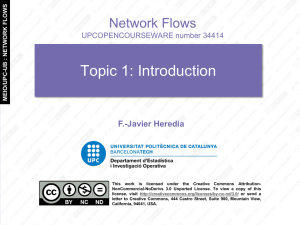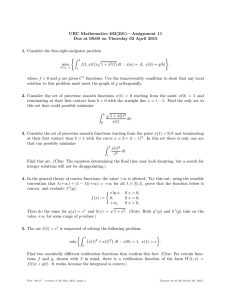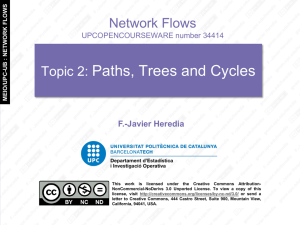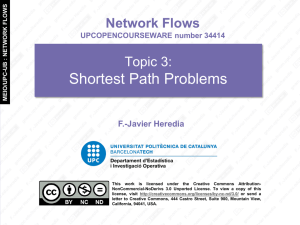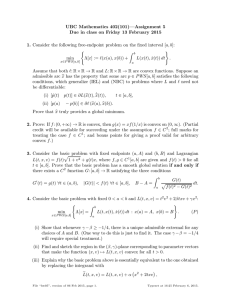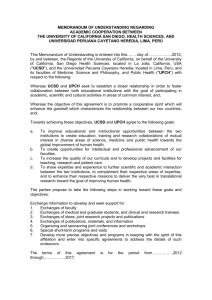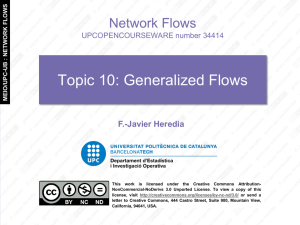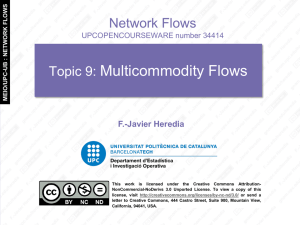Convex Costs Flows Network Flows Topic 7: F.-Javier Heredia
advertisement
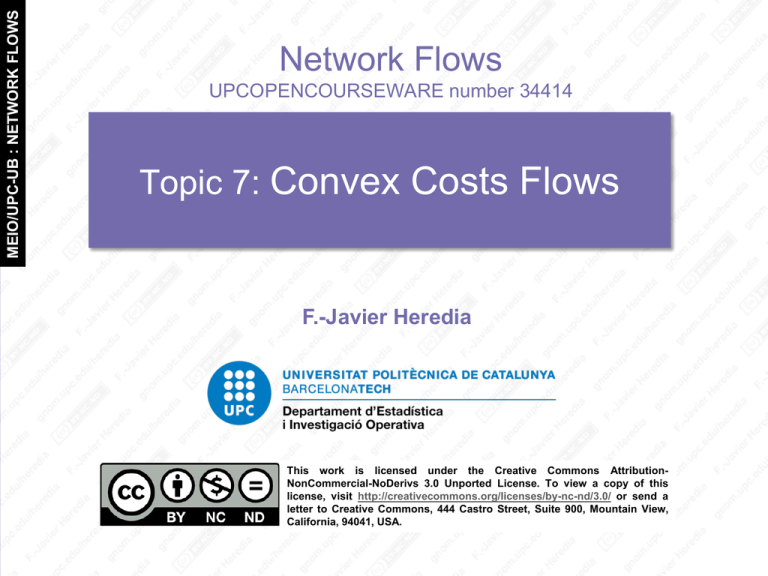
MEIO/UPC-UB : NETWORK FLOWS
Network Flows
UPCOPENCOURSEWARE number 34414
Topic 7: Convex Costs Flows
F.-Javier Heredia
This work is licensed under the Creative Commons AttributionNonCommercial-NoDerivs 3.0 Unported License. To view a copy of this
license, visit http://creativecommons.org/licenses/by-nc-nd/3.0/ or send a
letter to Creative Commons, 444 Castro Street, Suite 900, Mountain View,
California, 94041, USA.
•
•
•
•
•
Introduction
Applications
Transformations to a MCNFP
Pseudopolynomial Time Algorithms
Polynomial-Time Algorithm
• Source material:
– R.K. Ahuja, Th.L. Magnanti, J. Orlin “Network Flows”, chap. 15.
– R.K. Ahuja “Advanced Network Optimization”
http://www.ise.ufl.edu/ANO/
F.-Javier Heredia http://gnom.upc.edu/heredia
CCF- 2
Convex Cost Flows
MEIO/UPC-UB : NETWORK FLOWS
7.- Convex Cost Flows
• Convex cost flow problems are minimum cost flow
problems where the cost of flow is nonlinear.
Minimize
∑ (i, j)∈A Cij (x ij )
subject to
∑
{j:(i,j)∈A}
xij − =
∑ x ji
b(i) for each node i ∈ N
{j:(j,i)∈A}
0 ≤ x ij ≤ u ij and int eger for each arc (i, j) ∈ N
• Here we assume that the total cost is separable.
• The cost of flow Cij(xij) is a convex function of xij
instead of a linear function cijxij.
F.-Javier Heredia http://gnom.upc.edu/heredia
CCF- 3
Convex Cost Flows
MEIO/UPC-UB : NETWORK FLOWS
Introduction to Convex Cost Flows
• Some sample cost functions:
1000
40
800
30
600
20
Cij(xij )
400
10
Cij(xij ) 200
0
0
-10
0
2
4
6
x ij
8
10
0
2
6
4
8
10
x ij
(a)
(b)
F.-Javier Heredia http://gnom.upc.edu/heredia
CCF- 4
Convex Cost Flows
MEIO/UPC-UB : NETWORK FLOWS
Introduction to Convex Cost Flows
•
•
•
•
Urban Traffic Flows.
Area transfer in Communication Networks.
Matrix Balancing.
Stick Percolation Problem.
F.-Javier Heredia http://gnom.upc.edu/heredia
CCF- 5
Convex Cost Flows
MEIO/UPC-UB : NETWORK FLOWS
Applications
• We will assume that the cost of flow on any
arc is a piecewise linear convex function:
150
100
Cij(xij )
50
0
0
1
2
3
4
5
x ij
F.-Javier Heredia http://gnom.upc.edu/heredia
CCF- 6
Convex Cost Flows
MEIO/UPC-UB : NETWORK FLOWS
Piecewise Linear Assumption
• We will assume that each arc has p linear segments
associated with it. For example, if p = 5, then the cost
function would look like:
cij5
cij4
cij3
cij2
c1ij
dij0
d1ij
dij2
dij3
dij4
F.-Javier Heredia http://gnom.upc.edu/heredia
dij5
CCF- 7
Convex Cost Flows
MEIO/UPC-UB : NETWORK FLOWS
Nature of the Cost Function
•
The convex cost flow problem can be transformed to a minimum cost
flow problem by increasing the number of variables:
xij = x + x + x + x + x
1
ij
2
ij
3
ij
4
ij
xij3
x
x
c
c1ij
dij0
d1ij
xij5
cij5
xij4
cij4
cij3
2
ij
2
ij
1
ij
5
ij
dij2
dij3
dij4
F.-Javier Heredia http://gnom.upc.edu/heredia
dij5
CCF- 8
Convex Cost Flows
MEIO/UPC-UB : NETWORK FLOWS
Transformation to Min Cost Flows
• We replace each arc with p linear segments by p
arcs with linear costs.
Costs
i
Cij(xij)
Capacities
j
c1ij
d1ij − dij0
cij2
i
cij3
c
4
ij
cij5
dij2 − d1ij
j
i
dij3 − dij2
dij4 − dij3
j
dij5 − dij4
F.-Javier Heredia http://gnom.upc.edu/heredia
CCF- 9
Convex Cost Flows
MEIO/UPC-UB : NETWORK FLOWS
Transformation to Min Cost Flows (contd.)
• We call a flow in the transformed network to be a
contiguous flow if a segment with greater cost is
used only if segments of lower costs are saturated.
xij1
Flows
xij2
i
Cij(xij)
j
i
xij3
j
xij4
xij5
• There is a one-to-one correspondence between
flows in the original network and contiguous flows
in the transformed network.
F.-Javier Heredia http://gnom.upc.edu/heredia
CCF- 10
Convex Cost Flows
MEIO/UPC-UB : NETWORK FLOWS
Transformation to Min Cost Flows (contd.)
• A feasible flow in the transformed network
may or may not be contiguous.
• The optimal solution in the transformed
network is always a contiguous flow.
• We can solve the convex cost flow problem
by solving a minimum cost flow problem.
F.-Javier Heredia http://gnom.upc.edu/heredia
CCF- 11
Convex Cost Flows
MEIO/UPC-UB : NETWORK FLOWS
Transformation to Min Cost Flows (contd.)
• We can transform a convex cost flow problem into
a minimum cost flow problem and then solve it
using any minimum cost flow algorithm.
– The cycle canceling algorithm
– The successive shortest path algorithm
• However, the resulting minimum cost flow problem
may have too many arcs which might slow down
the algorithm.
• We will show that if we define the residual network
appropriately, then the network size will not
increase at all (that is, extra arcs can be handled
implicitly).
F.-Javier Heredia http://gnom.upc.edu/heredia
CCF- 12
Convex Cost Flows
MEIO/UPC-UB : NETWORK FLOWS
Pseudopolynomial-Time algorithms
150
i
(xij , u
ij
)
j
100
(3, 5)
i
Cij(xij )
j
50
(a)
0
0
1
2
3
4
5
x ij
i
x ij
j
i
1
1
1
j
1
1
i
rij
j
i
1
0
1
0
1
(b)
(c)
F.-Javier Heredia http://gnom.upc.edu/heredia
j
CCF- 13
Convex Cost Flows
MEIO/UPC-UB : NETWORK FLOWS
Constructing the Residual Network
• We need to maintain only two arcs for any arc (i, j): one
from node i to node j and another from node j to node i.
• For the exemple:
– Cost of the arc (i, j): Cij(xij + 1) - Cij(xij)
– Cost of the arc (j, i): Cij(xij - 1) - Cij(xij)
150
100
Cij(xij )
50
Cij(xij + 1) - Cij(xij)
Cij(xij - 1) - Cij(xij)
0
0
1
2
3
xij=
4
5
x ij
F.-Javier Heredia http://gnom.upc.edu/heredia
CCF- 14
Convex Cost Flows
MEIO/UPC-UB : NETWORK FLOWS
Constructing the Residual Network (contd.)
• What will be the costs and residual capacity of arcs in
the residual networks if xij = 5, 6, 10.
25
20
3
15
Cij(xij )
slopes
10
2
5
1
0
0
1
2
3
4
5
6
7
8
9
10
11
12
x ij
F.-Javier Heredia http://gnom.upc.edu/heredia
CCF- 15
Convex Cost Flows
MEIO/UPC-UB : NETWORK FLOWS
Constructing the Residual Network (contd.)
• The capacity scaling algorithm approximates
the convex cost function with greater
refinements (in terms of a parameter ∆).
• This algorithm is a modification of the capacity
scaling algorithm for the minimum cost flow
problem and has the same running time.
F.-Javier Heredia http://gnom.upc.edu/heredia
CCF- 16
Convex Cost Flows
MEIO/UPC-UB : NETWORK FLOWS
Polynomial Time Capacity Scaling Algorithm
MEIO/UPC-UB : NETWORK FLOWS
The Original Cost Function
Consider, for instance, Cij(xij)=xij4, linearized with step length
2000
1500
1000
Cij(xij )
0
0
1
2
3
4
5
6
7
8
9
10
11
12
x ij
F.-Javier Heredia http://gnom.upc.edu/heredia
CCF- 17
Convex Cost Flows
500
2000
1500
1000
Cij(xij )
500
∆=8
0
8
0
x ij
(a)
F.-Javier Heredia http://gnom.upc.edu/heredia
CCF- 18
Convex Cost Flows
MEIO/UPC-UB : NETWORK FLOWS
The Approximate Cost Function (∆ = 8)
2000
1500
1000
∆=4
Cij(xij )
500
0
0
4
8
12
x ij
(b)
F.-Javier Heredia http://gnom.upc.edu/heredia
CCF- 19
Convex Cost Flows
MEIO/UPC-UB : NETWORK FLOWS
The Approximate Cost Function (∆ = 4)
2000
1500
∆=2
1000
Cij(xij )
500
0
0
2
4
6
8
10
12
x ij
(c)
F.-Javier Heredia http://gnom.upc.edu/heredia
CCF- 20
Convex Cost Flows
MEIO/UPC-UB : NETWORK FLOWS
The Approximate Cost Function (∆ = 2)
2000
1500
∆=1
1000
Cij(xij )
500
0
0
1
2
3
4
5
6
7
8
9
10
11
12
x ij
(d)
F.-Javier Heredia http://gnom.upc.edu/heredia
CCF- 21
Convex Cost Flows
MEIO/UPC-UB : NETWORK FLOWS
The Approximate Cost Function (∆ = 1)
• For any arc (i, j) ∈ A with xij + ∆ ≤ uij, the ∆-residual
network contains the arc (i,j) with residual capacity ∆
and cost equal to
(Cij(xij + ∆) - Cij(xij))/∆
• For any arc (i, j) ∈ A with xij ≥ ∆, the ∆-residual network
contains the arc (j,i) with residual capacity ∆ and cost
equal to
(Cij(xij - ∆) - Cij(xij))/∆
F.-Javier Heredia http://gnom.upc.edu/heredia
CCF- 22
Convex Cost Flows
MEIO/UPC-UB : NETWORK FLOWS
The ∆-Residual Network
algorithm capacity scaling;
begin
x : = 0, π : = 0;
∆ : = 2 log U;
while ∆ ≥ 1
begin {∆-scaling phase}
preprocessing;
S(∆) : = {i ∈ N : e(i) ≥ ∆};
T(∆) : = {i ∈ N : e(i) ≤ -∆};
while S(∆) ≠ Φ and T(∆) ≠ Φ do
begin
select a node k ∈ S(∆) and a node l ∈ T(∆);
determine shortest path distances d(.) from node k to all other nodes in the ∆residual network G(x, ∆) with respect to the reduced costs;
let P denote a shortest path from node k to node l in G(x, ∆);
update π : = π - d;
augment ∆ units of flow along the path P;
update x, S(∆), T(∆) and G(x, ∆);
end;
∆ : = ∆/2;
end;
end;
CCF- 23
F.-Javier Heredia http://gnom.upc.edu/heredia
Convex Cost Flows
MEIO/UPC-UB : NETWORK FLOWS
The Capacity Scaling Algorithm
B
20000
Arc costs with scale factor 2
∆
15000
Arc costs with scale factor
∆
10000
D
A
5000
C
E
0
2
4
x ij -2 ∆
6
8
x ij - ∆
x ij
10
x ij + ∆
F.-Javier Heredia http://gnom.upc.edu/heredia
12
x ij+2 ∆
CCF- 24
Convex Cost Flows
MEIO/UPC-UB : NETWORK FLOWS
Going from One Scaling Phase to Another
• As we go from 2∆-scaling phase to ∆-scaling phase,
the costs of the arc (i, j) and (j, i) change and so their
reduced costs.
• There are four possibilities to consider after the
reduced costs are changed:
(1)
cijπ ≥ 0 and c πji ≥ 0
Nothing needs to be done.
(2)
cijπ ≥ 0 and c πji < 0
Decrease xij by ∆ units
(3)
cijπ < 0 and c πji ≥ 0
Increase xij by ∆ units.
(4)
cijπ < 0 and c πji < 0
This case cannot occur.
It can be show that the actions in (2) and (3)
conserve the RCOC.
F.-Javier Heredia http://gnom.upc.edu/heredia
CCF- 25
Convex Cost Flows
MEIO/UPC-UB : NETWORK FLOWS
Preprocessing
Theorem: In a scaling phase, the algorithm performs at
most m augmentations. Overall, the algorithm performs
O(m log U) augmentations, and its running time equals
solving O(m log U) shortest path problems.
F.-Javier Heredia http://gnom.upc.edu/heredia
CCF- 26
Convex Cost Flows
MEIO/UPC-UB : NETWORK FLOWS
Running Time Analysis

